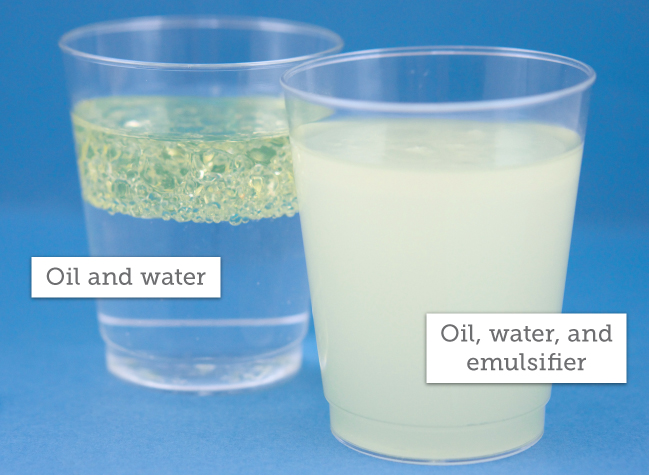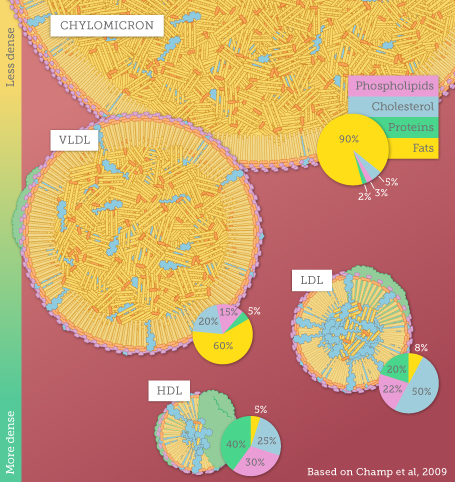Digestion
Since nucleic acids make up just a small proportion of the nutrients in our food, we don't detail their breakdown or storage in Metabolic Pathways or Building, Burning & Storing. But that's not to say they're unimportant. ATP is a nucleic acid, and it plays a role in just about every cellular process. Nucleic acids are also used for building DNA and RNA, as well as the carrier molecules NAD, FAD, and Coenzyme A.
Related content
To see how nutrients from our food are further processed by our cells, visit Metabolic Pathways.
Fats are transported in packages
We are made mostly of water. It accounts for about 65% of our body weight and more than 90% of our blood. And water makes up the bulk of our food and drink.
The breakdown products of proteins, carbohydrates, and nucleic acids dissolve in water. They can travel easily in the watery contents of our digestive system, bloodstream, and cells. But when it comes to fats, oil and water don’t mix. Fats require special handling.
In fat breakdown, above, you can see how bile salts help break fats from food into small droplets, giving them a greater surface area so that digestive enzymes can break them apart. In fat absorption, you can see how fats are packaged into chylomicrons and transported through the lymphatic system to the bloodstream.
This theme of wrapping fats in coated packages continues. Once they’re nearly empty, chylomicrons are taken up by the liver. Their remaining cargo is combined with fats that are made in the liver along with other lipids (including cholesterol) and packaged into VLDLs, or very low-density lipoproteins. VLDLs travel to all the tissues of the body, delivering their cargo where it is needed. As fats are removed, VLDLs shrink, and they become more dense (remember, fat floats on water). They soon become LDLs, or low-density lipoproteins. Eventually, when most of their fat is gone and they contain mainly cholesterol, they become HDLs, or high-density lipoproteins, which return to the liver.
Good and bad cholesterol
You may have heard of LDLs and HDLs in the context of cholesterol. LDLs are often called “bad cholesterol” and HDLs are often called “good cholesterol.” What’s important to remember is that low-density and high-density lipoproteins are packages that carry cholesterol and other lipids, not the cholesterol itself. Cholesterol is cholesterol, and all of our cells need it.
What's different is the characteristics of the packages. LDLs are out to deliver their contents, including cholesterol, to the tissue of the body. When LDL levels are high, they can get stuck on the walls of blood vessels, forming "plaques." This build-up can reduce blood flow, leading to heart attack or stroke. HDLs, on the other hand, are picking up cargo, including cholesterol, from the rest of the body and bringing it to the liver.
HDLs are considered "good" for a few reasons. First, some evidence suggests they can pick up cholesterol deposits from blood vessel walls, decreasing plaque build-up. Second, HDLs take cholesterol out of circulation. When they return to the liver, their cholesterol is converted into bile. Bile is dumped into the digestive tract, and some of it leaves in our feces—the only way we have of getting rid of cholesterol for good.

An emulsifier breaks oil into tiny droplets that can stay suspended in water. In the digestive tract, bile acts as an emulsifier. The proteins in chylomicrons and blood lipoproteins also act as emulsifiers, surrounding small droplets of lipids.

Fats and other lipids travel through the bloodstream in a variety of packages.
Taking up vitamins and minerals
In addition to the nutrients described above, our food contains "micronutrients"—vitamins and minerals that our bodies need to stay healthy. The digestive system absorbs these micronutrients, sending them to the bloodstream where they can travel to all of our cells.
Water-soluble micronutrients, such as vitamins B and C, dissolve easily in the watery contents of our digestive tract. The cells that line the gut take up these nutrients and transport them to the bloodstream.
Fat-soluble micronutrients, such as vitamins A and D, do not dissolve in water. Instead, they hitch a ride with fats, traveling in chylomicrons and VLDLs as described above. Eating a little fat with our food makes it possible to absorb these vitamins.
Some vitamins, such as K and B12, are made by microbes that live in the large intestine. They travel through the cells that line the large intestine and out to the rest of the body.
Water-soluble vitamins and other nutrients flow freely in the blood and digestive tract. Fat-soluble vitamins travel in packages with fats.
Alcohol absorbtion and breakdown
Ethanol from alcoholic beverages is absorbed directly through the lining of the digestive tract, mostly the stomach and small intestine. It is a small molecule, so it doesn’t need further breakdown before it can be absorbed. Ethanol mixes with water, and it travels readily through cell membranes. It diffuses easily in and out of capillaries and cells, from areas of higher concentration to areas of lower concentration.
Some ethanol leaves the body in the urine and through the skin, but most is broken down in the liver. Just like any other carbon-based fuel, ethanol is oxidized to form carbon dioxide and water, releasing energy in the process.
Liver cells can burn ethanol for energy.
Hydrolysis: the chemical reaction
Most food is broken down through a chemical reaction called hydrolysis. In Greek, “hydro” means water, and “lysis” means releasing, hydrolysis means releasing with water.
When two sugars are separated, or a chain of amino acids is taken apart, a molecule of water is added for each bond that is broken. Hydrolysis reactions are carried out by enzymes. Water wouldn’t react with these bonds on their own, but the enzymes make it more energetically favorable.
The reverse of this reaction is called dehydration synthesis: water is taken away as two molecules are bound together.
References
References
Champe, P.C., Harvey, R.A. & Ferrier, D.R. (2009). Lippincotts Illustrated Reviews: Biochemistry, fourth edition. Baltimore, MD: Lippincott Williams & Wilkins.
Marieb, E.N. & Hoehn, K. (2009). Human Anatomy and Physiology, eighth edition. San Francisco: Benjamin Cummings.
Salway, J.G. (2004). Metabolism at a glance, third edition. Malden, MA: Blackwell Publishing Ltd.